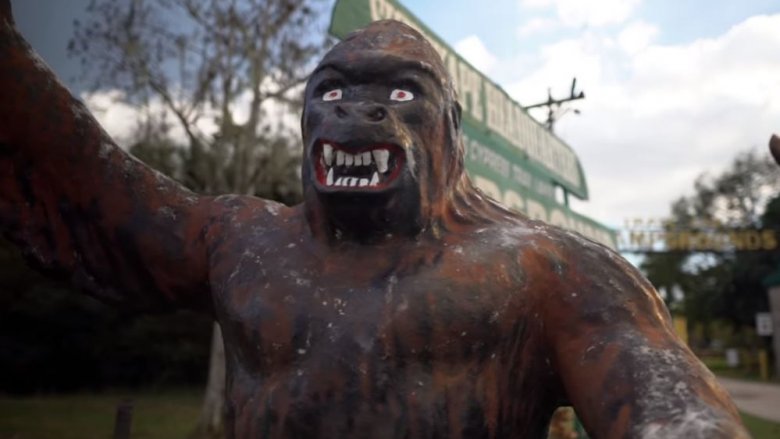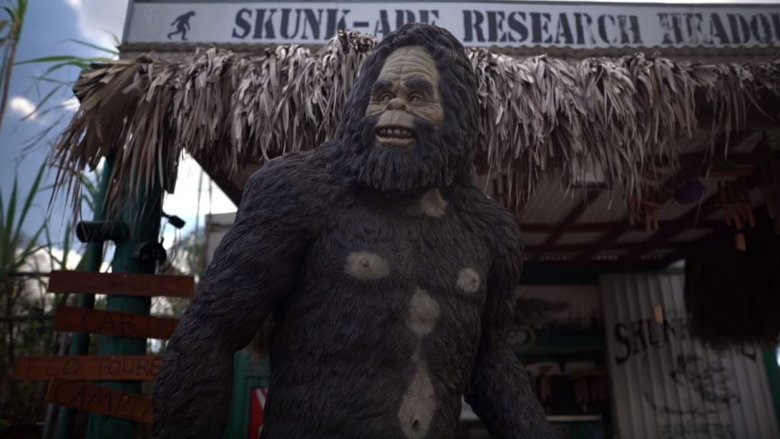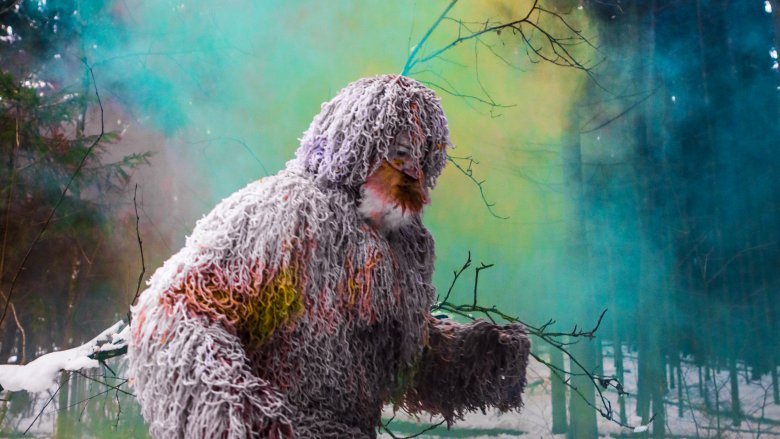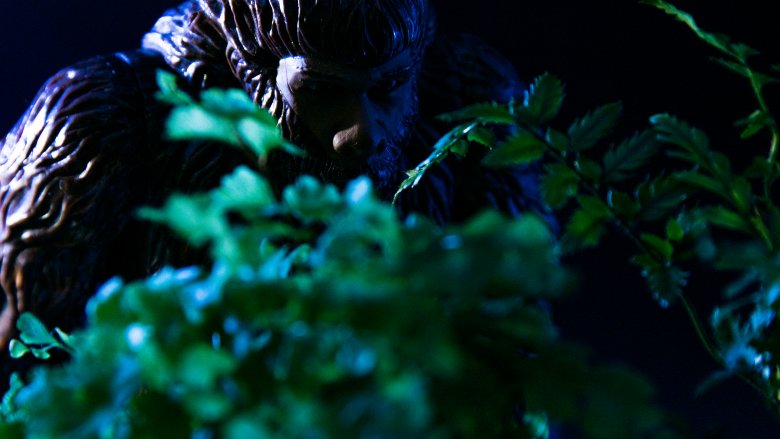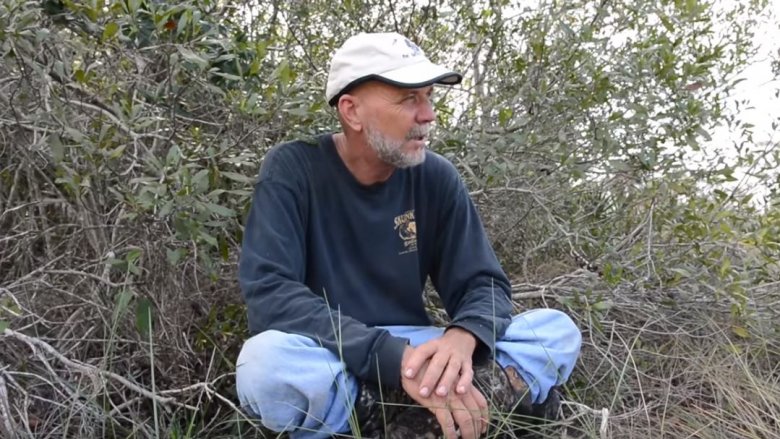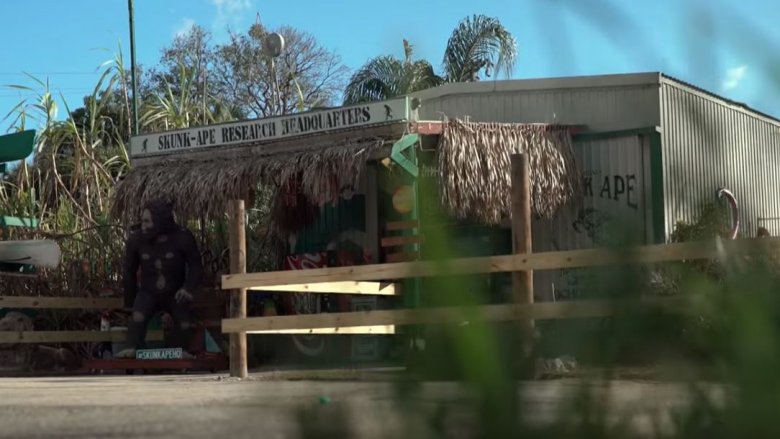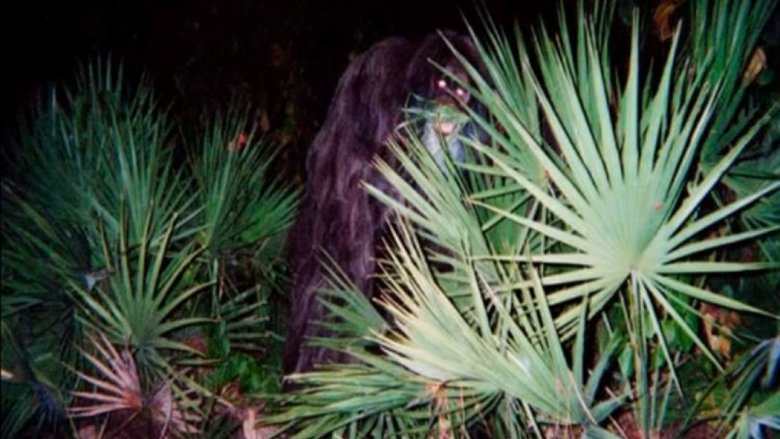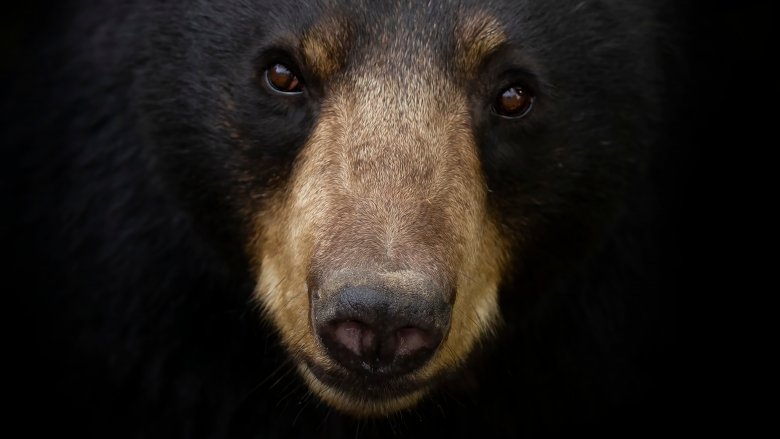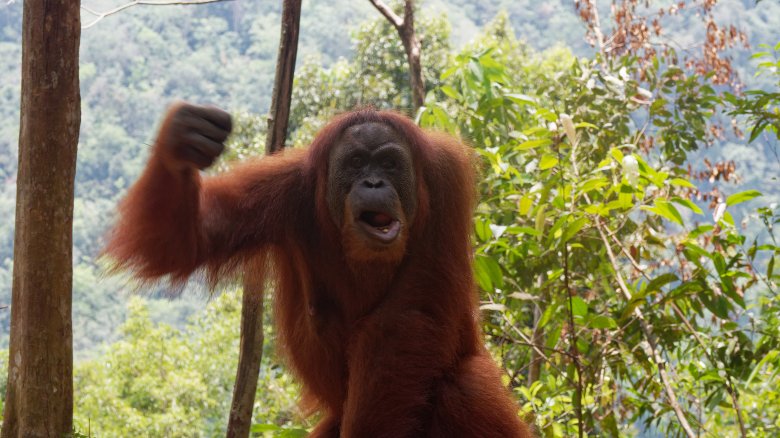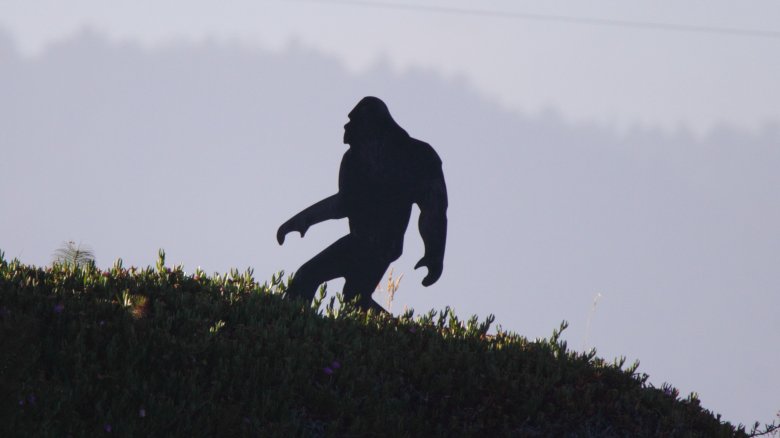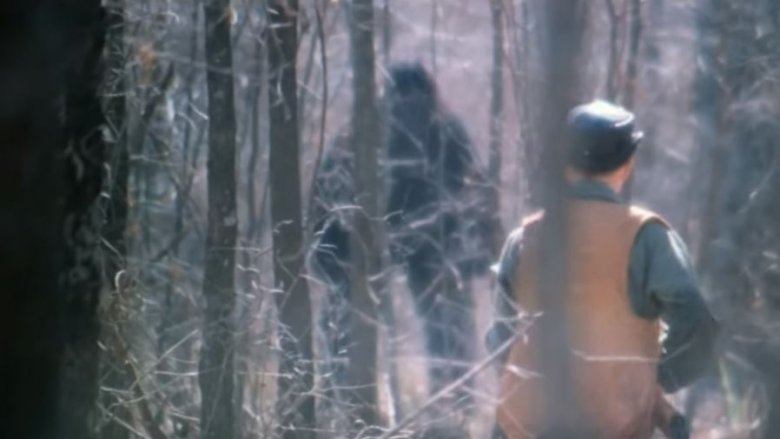The Untold Truth Of The Florida Skunk Ape
Florida's Everglades are a weird, wild, beautiful place, filled with countless mysteries and wonders. Alligators float through the waters. Manatees swim beneath. The Florida panther creeps across the swamp. According to comic books, a hulking Man-Thing protects the nexus of all realities. And, if you ask some people, the Everglades is also home to a hairy ape creature who possesses some seriously rancid B.O. problems.
Meet the Skunk Ape, Bigfoot's stinky — and equally elusive — cousin. While the latter creature tends to frequent the West Coast, and the Yeti keeps to the Himalayas, Skunk Apes prefer the warm, swampy side of life, and though these alleged critters have been sighted (and smelled) since all the way back in the mid-20th century, their existence has never been proven. Are they real or just a stinky hoax? Whatever your beliefs on Skunk Apes may be, these creatures have become a cult-favorite in cryptozoology circles, and here's why.
Okay, so why is it called a skunk ape?
Come on, you already know why it's called a Skunk Ape. Because it smells like a dumpster. Duh.
To delve a bit deeper into things, though, it's important to point out that while unwary reporters sometimes just use the label "Skunk Ape" as a synonym for Bigfoot, these creatures aren't interchangeable. For one, Skunk Apes tend to be smaller. As Atlas Obscura explains, eyewitness accounts generally describe the beasts as being between five and seven feet tall, and weighing only 250 or so — though that last part is probably a sketchy estimate, unless somebody keeps a scale out in the Everglades. Skunk Apes have only four toes, and their long, shaggy hair — often described as reddish, though sometimes black — more closely resembles an orangutan than a gorilla.
As for the Skunk Ape's infamous odor, well, that's often attributed to the Everglade's swamp gas clinging to their fur, combined with poor hygiene habits. They're like a roommate who works at the cheapo pizza place and never showers when they come home. According to Skeptical Inquirer, this foul aroma has also earned them such mean nicknames as the Stink Ape, the Swamp Monster, the Skunk Monkey, and the Bardin Booger. Ouch.
Anyhow, whatever you call them, these crazy creatures seem to have first been reported as far back as 1957, and they probably started getting identified as Skunk Apes with the dawn of the 1960s.
Like disco and bell bottoms, skunk apes thrived in the '70s
Now, while alleged Skunk Ape sightings speckled the Florida gossip vine throughout the '60s, it was the '70s when the creature's popularity gained full momentum. As close encounters multiplied, Skunk Apes started getting referenced in publications, by which point their unfortunate moniker became pinned to them like a button. If only the Everglades had a deodorant shop, eh?
According to Smithsonian magazine, more and more reports trickled in during this decade, and Skunk Apes were at one point even sighted as far north as the Florida panhandle. One particularly noteworthy sighting was reported as happening in 1974 to a little kid named Dave Shealy. The boy, only ten years old at the time, had previously noticed a series of mysterious four-toed footprints, when a fateful hunting trip with his brother supposedly brought the boys face to face with the abominable stink monster who'd left the tracks. As Shealy tells it, the creature's voyage across the swamp was halted by an unexpected rainstorm, which caused it to scamper off into the darkness. Short as this encounter might've been, it left a deep impression on the young Shealy, who still tells the story to this day. Remember his name, by the way, because you'll be hearing it a lot.
Skunky gets political
It might seem hard to imagine today, but back in 1977, people really believed that the increasing number of Skunk Ape sightings was a clear sign that, sooner or later, one of these hairy creatures would be caught, caged, and then turned into a zoo or circus attraction. Hey, this was decades before YouTube, okay?
Concern over the safety of these stinky apes grew feverish enough that Florida State Representative Paul Nuckolls from Fort Myers initiated House Bill 1664, better known as the "Skunk Ape Bill." This bill, if it had passed, would've prohibited the taking, possessing, harm, or molestation of "anthropoid or humanoid animals." And hey, honestly? If the Skunk Ape were real, such a gesture would actually be rather humanitarian and hopefully prevent a great deal of animal abuse from occurring. HB1664 did make it through committee, but it ended up being dumped before an official vote could happen. That's politics.
That said, Nuckolls — who once stated that,"I'd hate to see someone catch one and put it in a circus or in a zoo" — resurrected the Skunk Ape Bill the following year, only for it to meet the same fate. Sorry, swampy.
The Florida Skunk Ape's big comeback
So yeah, Skunk Apes were big celebrities back in the '70s. In the following two decades, though, they descended into B-movie has-beens. Sightings slowed down. People grew more skeptical. Bigfoot stole all the thunder.
Then, in 1997, according to the BBC, the odorous ape was sighted in the Everglades by multiple tour groups. An alleged 30 or 40 bus passengers all claimed to see a red-haired ape creature, according to Smithsonian magazine, and they weren't the only ones. Other Skunk Ape spotters included Jan Brock, a real estate agent, and even the local Ochopee Fire Department chief, Vince Doerr. The realtor snapped a photograph of the cryptozoological creature (or, you know, a person in a cool costume) right after it crossed the road in front of his car, while the fire chief said that while he could understand why some might think it was a bear, the creature he saw took the strides of a man.
Meanwhile, back to Dave Shealy! All this hubbub reignited the now-adult Shealy's interest in his weird childhood incident. He began leaving lima beans in the wild — supposedly, Stink Apes love these things — and soon, Shealy embarked on the study that would become his legacy.
Meet the world's foremost Skunk Ape expert
Arguably, the story of Dave Shealy's rise from eyewitness to cryptozoology expert runs directly parallel to the story of the Skunk Ape itself. To date, Shealy now claims to have seen the stinky primates four times, which has to be a world record. His second sighting, following the aforementioned tour bus incident, was the culmination of a six-month mission. In 1998, he claims that his search efforts paid off when, as he was hiding up in a tree, he spotted the creature splashing in the water beneath him. Two years later, he topped that by recording alleged footage of the creature shambling through the swamp. Finally, in 2011, he says that unexpectedly caught a whiff of the ape-man's familiar odor, saw the animal, and then watched it scamper off.
These days, Shealy not-so-modestly proclaims himself to be the Jane Goodall of Skunk Apes, and considering his dedication to the creatures — real or not — it's hard to argue with this assertion. According to Atlas Obscura, he currently believes that there are at least seven to nine of these things creeping around the Everglades. Though his life mission seems to revolve around spreading awareness about the creatures, he's also a proponent for their safety. He's fiercely against poaching, and tells anyone who sees a Skunk Ape to wait five days before reporting it, to ensure that the primate has time to get far away.
Shealy meets Colbert
Hey, Bigfoot might have more widespread name recognition than the stinky one, but he definitely doesn't have the killer spokesman that the Skunk Ape does. As the world's top Skunk Ape expert, Dave Shealy makes the media rounds fairly often, and you can count on him being cited, quoted, or interviewed pretty much anytime someone writes about these cryptozoological animals. Countless journalists have gone on Skunk Ape expeditions with him — though as The Apalachicola Times points out, these hunts never seem to find real Skunk Apes — and he's spoken to some pretty major networks and publications, including the Travel Channel, the BBC, Smithsonian magazine, and the TV show Unsolved Mysteries.
To be honest, though, probably Shealy's most unforgettable appearance was when he got interviewed by comedian Stephen Colbert, back when the latter was still just a reporter for The Daily Show. In front of the cameras, Colbert asked Shealy to remove his foot from his shoe, to prove that he wasn't the Skunk Ape himself, and Shealy obliged, showing good humor. That said, when Colbert asked what he thought of people who doubted the legend, Shealy admitted that he considered them to be, in his words, "Fools without facts."
Welcome to Skunk Ape HQ
Despite Shealy's clear dedication to promoting Skunk Ape awareness, some have questioned his authenticity, and there is a fair reason why. See, when Shealy isn't out promoting the Skunk Ape to the public, he runs the official Skunk Ape Research Headquarters in Ochopee, Florida.
For cryptozoology fans, this place is probably one of the most notable tourist attractions in the United States, and it's certainly easy to find, considering the life-sized Skunk Ape statue sitting out in front of it. The shop sells loads of monster memorabilia, including caps, T-shirts, shot glasses, and according to Atlas Obscura, Shealy's own personal illustrations of the elusive creature. The research center's website also advertises Skunk Ape hunts with Dave himself, as well as more ordinary tours of the Everglades for the less radical visitors. No, you probably won't see a Skunk Ape on any of these expeditions ... you know, other than the one standing out front.
The (alleged) story behind this classic skunk ape photograph
Anyone who's ever spent a late night googling weird stuff is probably familiar with the photo above, which might be the creepiest looking ape-man of all time. Seriously, can you say nightmare fuel? This picture, often called the Myakka photograph, is basically the Patterson-Gimlin footage of the Skunk Ape world. As Maine's famed Cryptozoology Museum founder Loren Coleman points out, this image got the attention of everything from Florida newspapers to Coast to Coast AM, and it's easy to see why. Once you look into those freaky, glowing eyes, they have a way of charring your soul. Brrr.
Shudders aside, what's the story behind the Myakka photograph? According to Mental Floss, the photo was sent in December 2000 to the Sarasota County Sheriff's Office by an anonymous woman, who described the creature as an orangutan. As she told it, she was just worried it might cause a traffic accident. Uh, okay, that's one huge orangutan. Unfortunately, since the anonymous woman has never been identified or come forward with more information, it's generally believed that the photos is a hoax ... albeit, a terrifying one.
The scientific community doesn't buy it
Now, Skunk Ape stories, mythology, and theories are fun, but from a scientific perspective, none of this means much. That's why biologists pretty much all agree that the Skunk Ape legend is probably a big ol' fake, unless more conclusive proof someday turns up. As it is now, the only real evidence for the creature's existence is eyewitness accounts, which is pretty weak. Where are the hair samples? The bodies? The feces? It doesn't add up, unless there are mystical portals in the Everglades or something ... though, hey, isn't that what Marvel's Man-Thing is guarding? Oh, right, that's fiction.
According to Skeptical Inquirer, many of the Skunk Ape sightings can probably be chalked up as misidentified black bears. Not only can black bears sometimes have reddish, cinnamon-colored fur (yes, the name is confusing), but they're also known to stand on their hind legs, with their arms dangling. If you were to see such a creature in the dark, walking toward you, it could easily resemble a hairy ape-man. Furthermore, these animals are known to snack from dumpsters, landfills, and trash piles, which could account for the nasty smell that they (aka the alleged "Skunk Apes") are known to produce.
However, not everyone agrees with this explanation ...
But wait, how could it be real?
No, Skunk Apes are (probably) not real. But it'd be really cool if they were, so it's fun to speculate on how such creatures could exist.
One favorite theory regarding the possibility of American apes, such as Skunky and Bigfoot, is that they could be the evolutionary offshoots of Gigantopithecus, a colossal primate that lived millions of years ago. Though Gigantopithecus fossils are generally only found in Asia, according to HowStuffWorks, cryptozoologists speculate that these creatures could've crossed an ice bridge to North America ... which is, for the record, believed to be the way that humans did it. One factor that particularly works in the Skunk Ape's favor with this theory is that Gigantopithecus' closest living ancestor is the orangutan. Not only are Skunk Apes said to resemble giant orangutans, but orangutans live far more solitary lives than other apes, which would line up with Skunky's elusive behavior.
Or not. Who knows? As for Dave Shealy, he has his own explanation for why Skunk Ape evidence never turns up. Objects decompose rapidly in swamps, he argues, and considering that the Everglades boast 2.2 million acres of protected land, most of it rarely disturbed by humans, it makes sense that bodies are never found. To be fair, if a mysterious ape creature was hiding out anywhere in the world, this would probably be one of the best places.
They aren't just in Florida, by the way
Everyone tends to associate the Skunk Ape with Florida, and while that's generally true — it's pretty much Florida's equivalent to the Loch Ness Monster, when you get down to it — the creature has been sighted (and more importantly, smelled) in other Southeastern U.S. locations. Back in 2003, for example, the murders of at least six cats and one dog in a Tennessee county were chalked up to a potential Skunk Ape. Hmm, maybe not the most credible assumption? Three years later, a YouTube user posted blurry, pixelated footage of a smelly ape creature in Franklin, North Carolina. It's not the most convincing video, since at least one fellow user claimed they could see the creature wearing jeans ... but hey, "evidence," nonetheless. Also in North Carolina, The News & Observer wrote of a man finding alleged skunk ape footprints in Medoc Mountain State Park. Some argue that Skunk Apes have even marched all the way to Arkansas, though residents there refer to it as the Fouke Monster.
So hey, Skunk Apes go traveling, when they feel like it. Usually, they stick to the Everglades, though, which is probably a good idea if they want to avoid further detection.
An array of stinky media appearances
Of course, a myth that goes on this long this can't help but inspire low-budget B-movies, and so it's only right that the Skunk Ape has left a media footprint. This includes the 2017 horror comedy Swamp Ape, which depicts a group of college researchers running into the mythical creature during an Everglades camping trip. The Arkansas version of the creature, known as the Fouke Monster, also served as the centerpiece of the 1972 cult hit The Legend of Boggy Creek, which apparently grossed about $22 million in ticket sales. Not bad, Swampy. It's a good thing that Smell-O-Vision has never become the norm, though, because the odor that a Skunk Ape leaves around doesn't sound like it'd be fun to experience in a movie theater.
The Skunk Ape — and Dave Shealy, of course — were also the key focus on an episode of the Discovery Channel's popular reality show Finding Bigfoot, where the team scouted Myakka Park for evidence of the creature. Spoiler alert: They couldn't prove anything, but hey, you knew that already.
